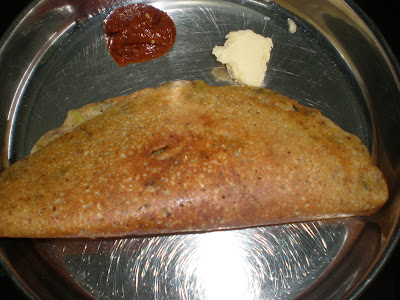.
This is a 'very easy to make' dosa. We don't need much ingredients too. When we have guests, we can prepare this dosa and keep it in a casserole and serve, unlike rava dosa, raagi dosa etc. which would be good/tasty, just right from the tava. Only thing is, the side dish should be a bit strong/hot, since this dosa is not prepared from sour/fermented batter, it will be bland. Many of my relatives love this dosa. Tastes a bit like 'aappam'.
Ingredients:
1. Raw Rice - 2 cups
2. Grated coconut - 2 tbsp.
3. Cooked raw rice/saadam - 2 tbsp.
4. Sugar - 1/4 tsp.
5. Salt - 1 tsp. or according to taste.
6. Hot, boiling water - 3 cups
7. Coconut oil - 2 tbsp.
METHOD:
Soak the rice for 4 hours at least. You can soak at night and grind and make the dosa in the morning. Or soak it in the morning and grind in a mixer and make the dosa in the evening or night. It is better to grind and make dosa immediately. You must add the coconut, cooked rice etc. and grind together. Add salt and sugar. Boil 3 cups of water and add to the rice batter. The batter should be very thin.
Keep the non stick tava on the stove. Heat should be medium. Take the coconut oil in a cup. Apply oil on the tava with an applicator, shown in the picture below or with the head/top of a brinjal. You can hold the top and use it as a stem, dip it in oil and apply on the tava. Pour the watery batter, like you do for rava dosa, on the tava. Close with a lid for half to one minute. You will know how long to keep after one or two dosas. Lift the lid and take out the dosa. Store them in a casserole. Apply oil again and make the next dosa. Dosas are ready!
You can eat the remaining dosa even after 4- 5 hours. They will be tasty. Not much oil is used in this dosa. Very easy to digest.
You can have this dosa with any hot chutneys like Onion Chutney, sutta kaththrikkai thogaiyal (Burnt brinjal chutney), peerkkangai thogaiyal (Ridgegourd chutney) or anyother hot chutney. Some like it with coconut milk (Coconut milk with jaggery). Or More kuzhambu, vaththal kuzhambu etc.
Try this and tell me how it came out and whether you liked it.
 |
| Thengaai Dosai with Peerkkangai thogaiyal and Sutta Kaththrikkai thogaiyal! |
This is a 'very easy to make' dosa. We don't need much ingredients too. When we have guests, we can prepare this dosa and keep it in a casserole and serve, unlike rava dosa, raagi dosa etc. which would be good/tasty, just right from the tava. Only thing is, the side dish should be a bit strong/hot, since this dosa is not prepared from sour/fermented batter, it will be bland. Many of my relatives love this dosa. Tastes a bit like 'aappam'.
Ingredients:
1. Raw Rice - 2 cups
2. Grated coconut - 2 tbsp.
3. Cooked raw rice/saadam - 2 tbsp.
4. Sugar - 1/4 tsp.
5. Salt - 1 tsp. or according to taste.
6. Hot, boiling water - 3 cups
7. Coconut oil - 2 tbsp.
METHOD:
Soak the rice for 4 hours at least. You can soak at night and grind and make the dosa in the morning. Or soak it in the morning and grind in a mixer and make the dosa in the evening or night. It is better to grind and make dosa immediately. You must add the coconut, cooked rice etc. and grind together. Add salt and sugar. Boil 3 cups of water and add to the rice batter. The batter should be very thin.
Keep the non stick tava on the stove. Heat should be medium. Take the coconut oil in a cup. Apply oil on the tava with an applicator, shown in the picture below or with the head/top of a brinjal. You can hold the top and use it as a stem, dip it in oil and apply on the tava. Pour the watery batter, like you do for rava dosa, on the tava. Close with a lid for half to one minute. You will know how long to keep after one or two dosas. Lift the lid and take out the dosa. Store them in a casserole. Apply oil again and make the next dosa. Dosas are ready!
You can eat the remaining dosa even after 4- 5 hours. They will be tasty. Not much oil is used in this dosa. Very easy to digest.
 |
| The batter should be watery. |
 |
| Oil applicator in wood. It is available in vessel shops. This way only very less oil can be used. |
 |
| The dosa should be covered for half minute. The dosa will not get roasted, but will be soft. |
 |
| Non-stick tava is good for this dosa. The dosa will slide down into the casserole! The work will be over very fast! |
 |
| Dosas are ready to eat! |
You can have this dosa with any hot chutneys like Onion Chutney, sutta kaththrikkai thogaiyal (Burnt brinjal chutney), peerkkangai thogaiyal (Ridgegourd chutney) or anyother hot chutney. Some like it with coconut milk (Coconut milk with jaggery). Or More kuzhambu, vaththal kuzhambu etc.
Try this and tell me how it came out and whether you liked it.













